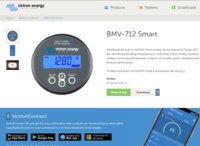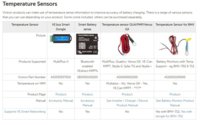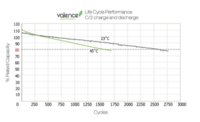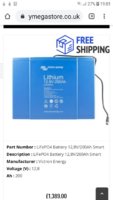Here we go, I've just completed testing on a Victron setup for LTD.
and @Deaky will be happy as its much less "Heath Robinson" solution.
so we have a Victron BMV712 smart battery monitor (monitor power/volt/amp levels in/out of battery) BMV-712 Smart - Victron Energy

Victron Temperature Sensor for BMV702/712 (provides temp/volt data for the BMV) Temperature Sensors [Victron Energy]

and a Victron - SmartSolar MPPT 75/15 (solar mppt charger) SmartSolar MPPT 75/10, 75/15, 100/15 & 100/20 - Victron Energy

The Temp sensor connects to the battery +v post and plugs into the BMV battery monitor. (monitors battery temp and supplies power to the BMV)

Thats about it.
The solar on the roof charges the battery via the MTTP.
The power in/out is monitored via the BMV
you can add your DC-DC as per below.
Now the cleaver bit, you create a VE-Direct bluetooth network via the Victron app, this enables the BMV to report the battery bank voltage and temp to the MPPT wireless via bluetooth..
The solar MPPT has its own setting in the lithium profile that you can now set the LTD point . . . say 5degC, so at that point the MPPT will stop charging the battery. (Solar MPPT LTD done!)
But what about my DC-DC charger? - how do i stop that from charging my batterys when cold? . . . . Well the BMV has a latching relay on the back of the display.
This can be set to do many things, but in out case we are setting it to be a LTD (this is a separate setting/adjustment to the mppt and works independently).
We set the alarm relay to open at below 4degC and to close again above 6degC (you can set whatever limits) we can now use this relay to interrupt the turn on signal for our DC-DC charger.
in our case its a Redarc BCDC charger that requires a ignition/run feed to start working. . . . . so if its to cold the BMV will keep the BCDC off untill the temp rises (by disabling the ignition feed to the dc-dc). (DC-DC LTD Done!)
No external cheap temp PCB`s, no external SCR or contractors, nothing get disconnected and no messing about . . . . . . . just a BMV (with temp), MTTP, DCDC
Now, as for a LBD, thats easy, just buy a victron battery protect unit and set it to 11.5v disconnect then wire between the loads and +v battery terminal - but ill show that a different day.
More detailed look into things below . . . . . . .

what we see below is the BMV now reporting the battery temperature . . . . 18degC


below we can see the temp is being reported to the MPPT . . . 19degC

here we can set the low temp disconnect for the solar mppt.....in this case 10degC for testing.

i set the LTD to below 10degc at this point we are still charging at 45W . . . .

but . . . . . i use brake-clean to freeze the battery terminal to drop the temp . . . when the temp went below 10degC for 10seconds the MPPT charger shut off ( it doesnt say its off, but the PV and solar side drop to 0A and 0W)

as the temp rises again the solar MPPT will restart and start charging again.

Its the same with BMV . . . . you set the relay lower and upper temp ranges and thats-that . . . . just use that relay to shut off your DC-DC charger.
. end.
.
and @Deaky will be happy as its much less "Heath Robinson" solution.
so we have a Victron BMV712 smart battery monitor (monitor power/volt/amp levels in/out of battery) BMV-712 Smart - Victron Energy

Victron Temperature Sensor for BMV702/712 (provides temp/volt data for the BMV) Temperature Sensors [Victron Energy]

and a Victron - SmartSolar MPPT 75/15 (solar mppt charger) SmartSolar MPPT 75/10, 75/15, 100/15 & 100/20 - Victron Energy

The Temp sensor connects to the battery +v post and plugs into the BMV battery monitor. (monitors battery temp and supplies power to the BMV)

Thats about it.
The solar on the roof charges the battery via the MTTP.
The power in/out is monitored via the BMV
you can add your DC-DC as per below.
Now the cleaver bit, you create a VE-Direct bluetooth network via the Victron app, this enables the BMV to report the battery bank voltage and temp to the MPPT wireless via bluetooth..
The solar MPPT has its own setting in the lithium profile that you can now set the LTD point . . . say 5degC, so at that point the MPPT will stop charging the battery. (Solar MPPT LTD done!)
But what about my DC-DC charger? - how do i stop that from charging my batterys when cold? . . . . Well the BMV has a latching relay on the back of the display.
This can be set to do many things, but in out case we are setting it to be a LTD (this is a separate setting/adjustment to the mppt and works independently).
We set the alarm relay to open at below 4degC and to close again above 6degC (you can set whatever limits) we can now use this relay to interrupt the turn on signal for our DC-DC charger.
in our case its a Redarc BCDC charger that requires a ignition/run feed to start working. . . . . so if its to cold the BMV will keep the BCDC off untill the temp rises (by disabling the ignition feed to the dc-dc). (DC-DC LTD Done!)
No external cheap temp PCB`s, no external SCR or contractors, nothing get disconnected and no messing about . . . . . . . just a BMV (with temp), MTTP, DCDC
Now, as for a LBD, thats easy, just buy a victron battery protect unit and set it to 11.5v disconnect then wire between the loads and +v battery terminal - but ill show that a different day.
More detailed look into things below . . . . . . .

what we see below is the BMV now reporting the battery temperature . . . . 18degC


below we can see the temp is being reported to the MPPT . . . 19degC

here we can set the low temp disconnect for the solar mppt.....in this case 10degC for testing.

i set the LTD to below 10degc at this point we are still charging at 45W . . . .

but . . . . . i use brake-clean to freeze the battery terminal to drop the temp . . . when the temp went below 10degC for 10seconds the MPPT charger shut off ( it doesnt say its off, but the PV and solar side drop to 0A and 0W)

as the temp rises again the solar MPPT will restart and start charging again.

Its the same with BMV . . . . you set the relay lower and upper temp ranges and thats-that . . . . just use that relay to shut off your DC-DC charger.
. end.
.
Last edited:












































